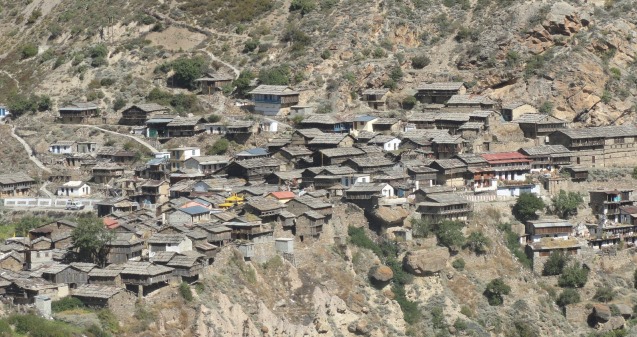After finishing his Masters in Biodiversity and Conservation, Conservation Leadership Programme Alumnus Pramod Kumar Yadav embarked on an enthusiastic career studying the biodiversity, topography and spirituality of the Himalayas. Here, he shares his experiences and reveals his delight at being granted a 2015 CLP Award…
The first time I visited the Himalayan Mountains was with my school friends for an educational expedition when I was 14 years old. Before then I had only read about the mountains, having been born and educated in the plains of eastern Uttar Pradesh and Delhi.
This trip was the first time I got to experience the high mountains, deep gorges, beautiful valleys of the Himalayas and meet the people who lived there.
During this expedition, I pondered a lot about the education of the region’s children and about the livelihoods and prosperity of the mountain dwellers because I did not see any signs of agricultural fields, industry setup or educational infrastructure in those areas.
To me this seems strange, because I was born and spent my childhood in a village surrounded by vast agricultural lands without mountains and forests.
During my Master’s dissertation, I got an opportunity to work with the indigenous Garo community in the eastern part of the Indian Himalayan region. The people here live in poverty, relying on shifting cultivation (which gives little return) and a collection of forest products as the main livelihoods in an area that lacks basic facilities for education, health care, or most importantly any alternative avenues for income generation.
I believe it was these early experiences that brought me closer to the profession of conservation biology and inspired me to work for the prosperity and sustainability of the people and towards an eco-friendly Himalaya.
Caterpillar fungus
I started my professional career by exploring biodiversity, environmental issues and scarcity of local communities in the Indian central Himalayas in 2012. In July last year, I visited the Nanda Devi Biosphere Reserve with my colleagues Mr. Subhajit Saha and Dr Ashish K. Mishra (both are team members of the CLP project) to assess different environmental issues arising from several development projects in the area.
We met with the local communities and tried to assess the impact of the developments on both the people and the biodiversity of the Biosphere Reserve. It was during this assignment that we came to hear about another issue in the area: the harvesting and trade of the caterpillar fungus (Ophiocordyceps sinensis) locally known as Kira Jari, which is used as an aphrodisiac and to treat a range of health problems.
Collecting the fungus from its natural habitat is not an easy task. According to those we spoke to, some people climb to altitudes as high as 3,500 to 4,000 meters to obtain the rare fungus.
Much like gold, it is worth a lot, but the work required to obtain the Kira Jari is not for the meek.
But as one of our respondents asked us: “Why would I migrate to Delhi or Dehradun to work in hotels when I can earn in one season what I can make over there in two years?”
But there is a dark side to the fungus collection. In addition to having to brave harsh climates to find it, its rarity means that there are no guarantees that a collector will find anything substantial at all.
Some villagers return with nothing to show for their weeks of hardship in high altitude snow fields and many even fall ill as a result of the exertion.
Searching for the fungus involves lying on your front, elbows dug into the scree and snow, scouring the ground in front of you for nothing larger than the stalk of an apple. It is freezing cold and there is a howling wind, making your lungs ache. People often return to the village with snow-blindness, painful joints and breathing problems.
The business is also generating rivalries between collectors and the competition is often violent. Entire villages battle one another for the right to collect Kira Jari in certain areas. There are other risks too as although it is legal to collect the fungus, it is not legal to sell it.
Last year, after tireless efforts from all of our team in preparing an application, we were thrilled to receive an e-mail from the Conservation Leadership Programme to tell us that we had been awarded the funding we needed to start exploring the impacts of fungus harvesting activities on both the mountain communities and ecosystems.
My reaction to the news was, “Oh! Finally we made it!”
Our dream is for a sustainable and prosperous Himalaya and at last I felt like we were making progress towards this dream.
I have a very special place in my heart for the CLP award because it will provide us the first international platform to interact with other leading conservation professionals around the world, not to mention a huge boost in morale. We all are young natural resource professionals and this award will be immensely constructive towards our greater research goals.
They say that the greatness of India is a gift from the Himalayas. This is quite logical given the immense influence that the world’s greatest mountains have on everything from climate to culture that is Indian.
It is also a well-known fact that if we adversely change the ecology and the topography of these mountains, it might just trigger several disasters that could have the potential to change the demography of the region towards a catastrophic collapse. Phenomena like floods, droughts, changing river courses, the retreat of glaciers etc. have already been observed in the region.
Sustainability therefore, is paramount when we plan to exploit the natural resources of the Himalayas – to make sure that these remarkable mountains can continue to give its wonderful gift.
This post was originally posted on Fauna & Flora International‘s website.





